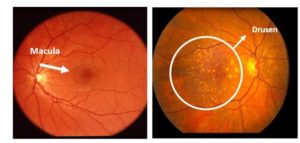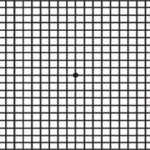February is Macular Degeneration/Low Vision Month!
Macular degeneration is the leading cause of vision loss for people 60 and older. The macula is an area in the back of the eye. It is a part of the retina which lines the inside of the eye. The macula is responsible for detailed vision and color vision. It is the part of the eye we point our eyes with to see straight ahead.

When the area that normally provides nutrients and carries away waste from the macula is damaged, it forms drusen. Drusen are yellow deposits that form under the retina that are due to the waste that is unable to be taken away. This disrupts the ability to see in that area. The picture on the left shows a normal healthy retina and the picture on the right shows drusen in the macula area.

The disease process can be slow in some, where there is hardly a noticeable change in vision over time. In others, it can progress faster and lead to vision loss in one or both eyes. The area of vision loss is in the center. This figure gives a representation of how macular degeneration can affect the central vision. It can look either darkened and/or wavy, depending on how and where the macula is affected.

Here are some risk factors and things that can help decrease the risk of getting macular degeneration.

As you can see from the figure, there are some modifiable risk factors. Smoking is a big risk factor along with UV damage. Avoiding smoking and wearing sunglasses can help to prevent or delay vision loss caused by macular degeneration. Also, green leafy vegetables such as spinach and kale are rich in the macular pigments lutein and zeaxanthin. These nutrients help build the layer that is damaged in macular degeneration, helping the macula to maintain healthy vision longer. Supplements are also available with lutein and zeaxanthin.
In every routine exam, we examine your macular area for any signs of macular degeneration and assess your vision. If there are any areas affected, we may have you do an additional test called the Amsler Grid.

This test can show which area of functional vision is affected and see if it changes over time. The black circle in the center is looked at and a notation is made of any changes in the grid. Here are examples of what a person with macular degeneration may see on the Amsler Grid.

As of this time, there is no cure for macular degeneration. Reducing risk with lifestyle and diet modifications is the best option to try to prevent the disease. If damage to the macula progresses, injections may be used to prevent further vision loss. Macular degeneration does not cause complete blindness as it does not affect peripheral vision. An evaluation with a Low Vision Specialist can help someone learn how to use their remaining vision with devices such as a magnifier.
Smoking cessation, sun protection, eating more leafy green vegetables and taking supplements can help. Two long term studies (10 years each) on supplements have been done called the AREDS study. This is a combination of vitamins and macular pigments that showed a decrease in the progression of macular degeneration. Current treatments are based on these studies and research is ongoing.




